Rainy season is coming—time for a new roof
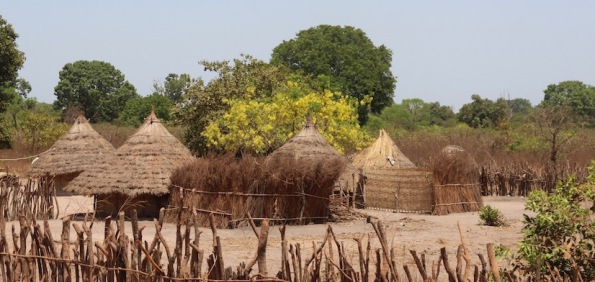
Bundles of grass in front and to the side of four huts
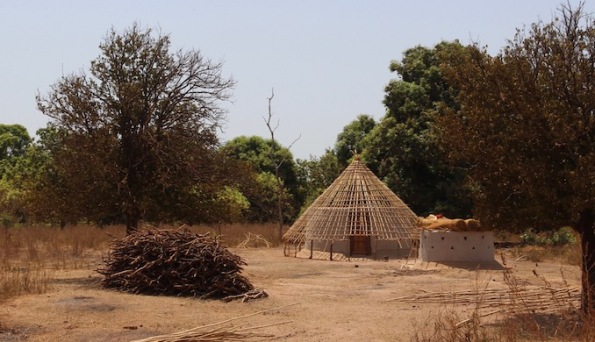
The roof is framed and the grass bundles are on the right
Overland travel gives us a great chance to observe daily life in towns, villages and the countryside.
As we’ve moved from country to country in West Africa, one of the most noticeable differences is the style of housing and construction. Some differences are slight while others are more varied. Northern Guinea and Guinea-Bissau were the first places where I saw simple roofs being repaired for the rainy season. Maybe this is now happening in all the countries we’ve already visited.
When I first saw the bundles of grass in the two Guineas, I assumed they might be feed for animals, but it didn’t take long to realise this was roofing material for buildings covered in thatch. I don’t know how much the grass costs or how much it takes to cover a roof.
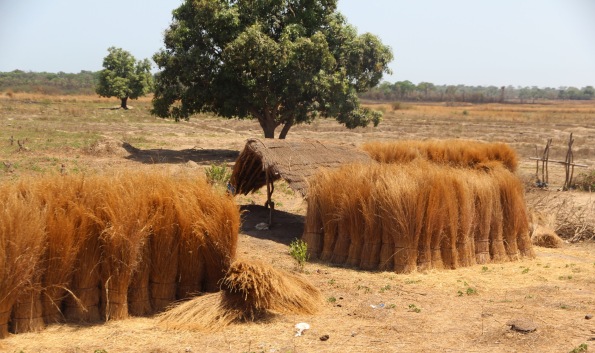
Grass for roofs
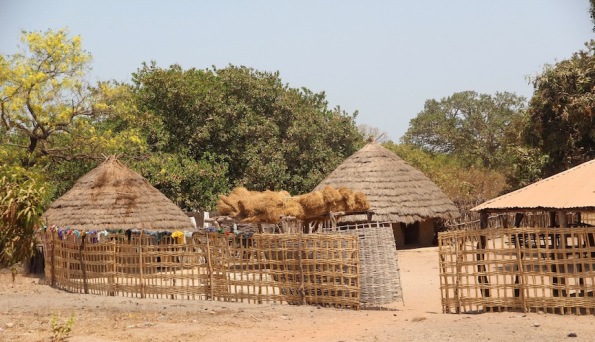
Roofing materials stored off the ground and a style of fencing I hadn’t seen before
I thought you might enjoy seeing the various stages in the process.
As an aside, we took a two-hour boat trip through extensive mangroves in The Gambia. Our guide, Omar, is rushing to get his house built (or at least enclosed) before the rains begin in June. He is using corrugated iron for the roof. He needs 10 packets of the stuff—I don’t know how big a packet is—at 1800 Gambian dalasis per packet. That’s equal to about 330 euros for all 10 packets. So far, he’s purchased four packets of new roofing material and hopes to find cheaper secondhand materials for the rest. We tipped him generously.
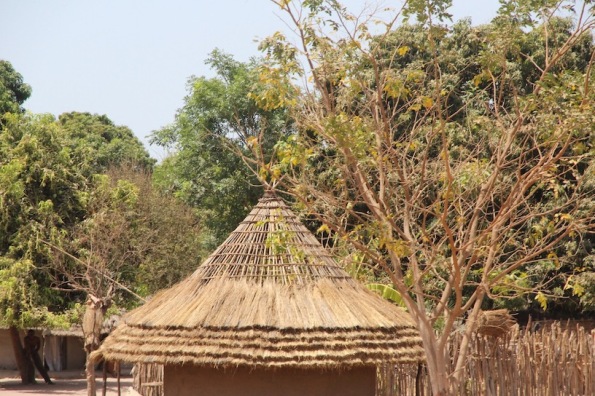
Roof in progress
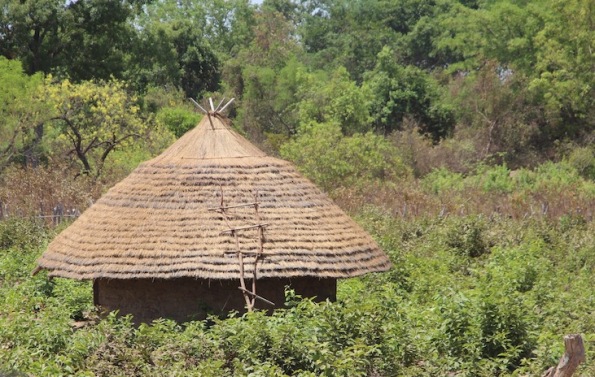
Finished roof

It costs several thousand £ to rethatch a roof in the UK, it’s actually skilled trade that is being lost
The last roof I saw being thatched took nearly 5 days and that was 2 blokes working from sun up to sun down (a very long day)
That was on an old farm house near me, nearly 500 years old, (it’s now a protected building because of the thatched roof). The roof had been thatched quite a lot over the years, it provided homes for lots of birds, bugs, bats, squirrels over the years (they used 4 poster beds in conjunction with a thatched roof, the sheet above the bed caught the wildlife if it fell from the thatch, assuming they never had a lift)
LikeLiked by 8 people
Oh my goodness, Derrick, I think you just explained the main reason for four-poster beds! Many thanks for that.
LikeLiked by 1 person
It was very interesting to see the work in progress. We, like the commentator above, once saw a thatched roof under repair in either England or Ireland, I don’t recall which. They look charming, but I’ll pass.
LikeLiked by 3 people
I’m with you. I’ll stick to a normal roof—whatever that is. 🙂
LikeLike
Slate, tile, even grass turfs make good roofs
Another is glass and polycarbonate, the main thing is to protect you from the elements, keep you warm or cool
In the Amazon, banana leaves are used (mainly from the down pours every day)
The more you travel the more roof coverings you will find (even in your home countries)
I have a glass roof in my conservatory so it can be used in the winter, in the summer we use blinds to stop it getting too hot
I have a tile roof, because it’s what was used when it was built 55-60 years ago, it’s still good, then tiles were cheap, slate is the most expensive now I think (slate roofs are nearly as expensive as a thatched roof)
LikeLiked by 1 person
Derrick, you make me realise that I need to pay more attention to roofs. Thanks.
LikeLiked by 1 person
As Derrick commented, thatching is still widespread in the UK, especially where I live, in East Anglia. But it lasts a lot longer than one season here, which is just as well, given the cost.
Best wishes, Pete.
LikeLiked by 3 people
I have to confess that I don’t know exactly how long the thatch lasts in Africa. Not everyone seemed to be doing their roof, so they may have a couple of years in them.
LikeLiked by 1 person
I would think that some galvanized tin material would be more permanent for roofs. It might cost more initially, but stronger and lasts longer. Or some old metal scarps from say a junked car. However, the thatched roofs look nicer.
LikeLiked by 2 people
You obviously haven’t been inside anywhere that has a tin roof, when it rains it can be really loud, there is no way you could sleep through a rain storm, where in a thatched roof does the same job, but quietly,
A thatched roof can last 5 years or more, the thicker the better (it’s not just a roof for rain, it’s also insulation, which you won’t get with a tin roof
Corrugated sheets aren’t widely available in west Africa, where as grass (thatch) is.
LikeLiked by 3 people
Derrick makes a great point. Thatch is easily available, whereas the corrugated sheets are less common.
LikeLike
Lots of roofs here are done here with old metal scraps and then held down with rocks. A big wind makes a mess of them.
LikeLike
A lovely post-Peggy Thatch is used here but corrugated sheets are very popular just so noisy to be inside a house. with a tin roof when it rains heavily…Love reading about your travels 🙂
LikeLiked by 2 people
Thanks Carol. I appreciate your visits. And I know how noisy tin roofs can be!
LikeLike
We lived under a thatched roof of an old Saxon farm house in Holland for a few years. At one stage it needed re-thatching which was paid for by the Government under ‘natural monuments.’ It is a great insulator but also flammable , the thatchers also installed lightning deflectors around the edges and sides of the roof.
Thatched roofs are very romantic and inviting. They seem to want you to huddle under it and protect you from the elements. Not sure that the colour-bond zinc-alume corrugated roof beckons in quite the same way.
LikeLiked by 3 people
Thanks for sharing your story about living under a thatched roof. Interesting and worthy that the government pays for the re-thatching.
LikeLike
I’ve never lived under one but they seem very cosy.
Thanks for sharing your travels – very enjoyable. 🙂
LikeLiked by 3 people
Thanks for coming along on the journey.
LikeLiked by 1 person
Wow! We in first-world countries take so much for granted. My roof is red tiles, a fairly new one (18 years now) because the original red tile roof leaked so badly we had to move furniture out of the living room during the winter. But the leaks were due to poor and illegal construction, discovered when the new one was put on. We were lucky to be able to replace our roof. Honestly, I don’t think I could bear a roof with animals raining down on me. Gees, we are spoiled. What a fascinating post this is. Thatch roofs are charming to see but they are veritable zoos.
LikeLiked by 3 people
Glad you’re not living with a leaky roof now. I suspect the African versions of thatch are buggier than the European ones.
LikeLiked by 1 person
(I only clicked on “Like” so you’d know I read your response – not because I think buggy African roofs are wonderful.)
LikeLiked by 1 person
They look a bit like the thatched roofs we have in the UK 🙂
LikeLiked by 3 people
I think the UK ones are much thicker (probably for colder weather).
LikeLike
There are still quite a few old cottages in Ireland with thatch, some are new-builds, built as holiday homes for the tourists. I think most people prefer the convenience of a tiled roof these days. Fascinating to see the African version.
LikeLiked by 3 people
Interesting to know that some new-builds are using thatch. The tourists must love them.
LikeLiked by 1 person
I think they do because they are nice big modern version of a tiny Irish tatched cottage. All the appeal of the old with none of the hassles!
LikeLiked by 1 person
Good to see this variation on the thatching that surrounds us
LikeLiked by 3 people
Maybe someday I can do a post on English thatch. Just need to get there. 🙂
LikeLiked by 1 person
🙂
LikeLiked by 1 person
If you do ever get here, I can offer you a bed and a meal (just paying you back for my Oz trip)
LikeLiked by 2 people
Thanks Derrick. We’ll work on getting there.
LikeLike
What an interesting post. I’m intrigued. 👀🍃
LikeLiked by 3 people
Stay tuned for more to come.
LikeLiked by 1 person
I watched a few being built, Peggy. Bug-a-bug (termite) dirt from termite mounds was mixed with water and then carefully placed in woven wood structures to form walls. The mud could also be turned into bricks for more sophisticated structures. One such operation had been right next to our house. Driver/army ants chose the old bricks as a home during rainy season. That was right before they attacked us and we went to war! 🙂 –Curt
LikeLiked by 3 people
Oh geez, army ants. I hope you won the war or at least stayed ahead. I’ve seen those bricks being made. Fascinating.
LikeLike
Very cool. It’s been a while since I’ve been on WP, but now I remember you were doing overland in West Africa. So fascinating. Seems like it would be quite challenging.
LikeLiked by 3 people
It’s been getting less challenging as we move north.
LikeLike
Oh wow, all the layers…no wonder so many packets are needed. I hope Omar gets his roof done in time!
LikeLiked by 2 people
I hope so too. The rains arrive in June.
LikeLiked by 1 person